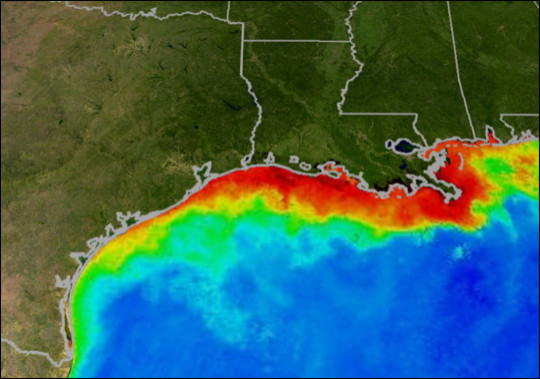'Dead Zone' In Gulf Of Mexico Expected To Be Extra Large This Year

Fertilizer runoff carried from the Midwest by heavy spring rains could lead to a New Jersey-sized “dead zone” in the Gulf of Mexico this year, the U.S. National Oceanic and Atmospheric Administration said.
“Dead zones” in the ocean are areas with little or no oxygen, caused by excessive pollution, usually from agriculture. Nitrogen, phosphorus and other nutrients from fertilizer runoff provide the fuel for algal blooms and populations of certain bacteria. When the nitrogen-eating algae die, the bacteria that feed on them are also consuming oxygen, and leaving little to support other marine life. The area becomes the watery equivalent of a desert.
Last year’s dead zone in the Gulf was covered about 2,889 square miles – the size of Delaware. That patch was the fourth-smallest on record, largely thanks to widespread drought conditions. But now the rains have returned, and more fertilizer is flowing down South.
Scientists at the University of Michigan, Louisiana State University and the Louisiana Universities Marine Consortium, working in partnership with NOAA, examined data on nutrient runoffs collected by the U.S. Geological Survey. They found that 153,000 metric tons of nutrients surged along rain-fueled rivers into the Gulf in May, a 16 percent increase over the average nutrient flow over the past 34 years and a 94,900 metric ton increase over last year’s flow.
In accordance with the data, the researchers forecasted that this year’s dead zone in the Gulf could be between 7,286 and 8,561 square miles. If the zone reaches the high end of that estimate, it would surpass the previous largest dead zone recorded in 2002.
However, if there's a significant tropical storm in early to mid-July, the officially measured size of the dead zone could drop as low as 5,344 square miles, NOAA said. The final confirmed size of the Gulf dead zone will be released in August.
Bloomberg View editor James Greiff pointed out in an opinion piece that there’s one crop in particular that bears much of the blame for runoff pollution.
“The culprits behind the dead zone are many, but one deserves special attention: corn,” Greiff wrote. “Unlike, say, soybeans, which can grow without fertilizer, corn can't grow without it. It takes 195 pounds of fertilizer to grow an acre of corn.”
Greiff said that the runoff issue is another reason why Congress should kill the ethanol mandate, which is one big factor in the U.S.’ massive corn crops. Fuel companies have to blend corn ethanol in with gasoline in accordance with a 2007 renewable fuels law. The amount of ethanol required to be blended in with gasoline is set by the U.S. Environmental Protection Agency each year.
The extent of this year’s dead zone could spell trouble for fish and shellfish populations in the Gulf, which is still recovering from the Deepwater Horizon disaster and oil spill. Recently, BP and federal officials said they were ending official spill cleanup actions off of the coasts of Mississippi, Florida and Alabama. Louisiana officials have already criticized the oil company and federal officials in an attempt to forestall the ending of cleanup operations in that state, the Times-Picayune reported on Wednesday.
© Copyright IBTimes 2024. All rights reserved.




















